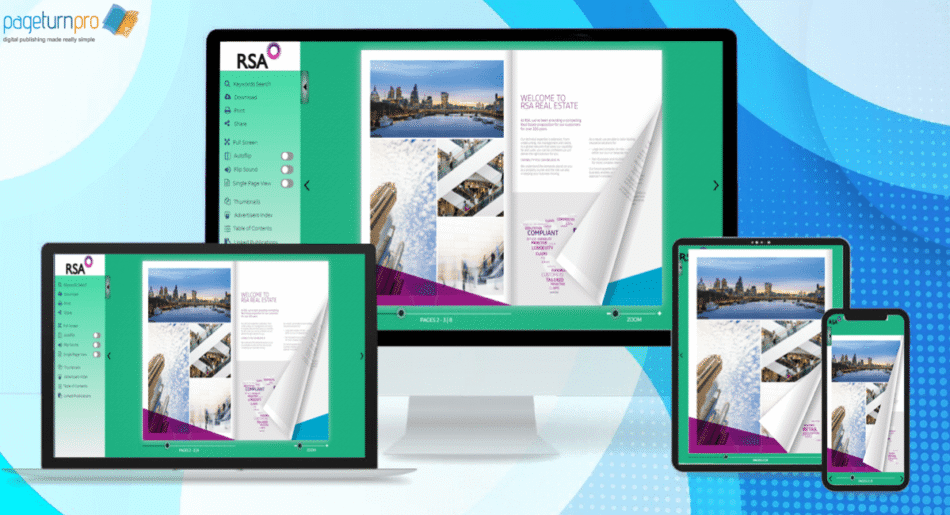Publishing has witnessed a digital revolution, but most companies continue to make enormous use of conventional print materials. From marketing brochures to company annual reports, the environmental impact of paper-based publishing continues to add up. Flip book software provides an attractive alternative that unites visual beauty with environmental sustainability.
Understanding the Environmental Impact of Traditional Publishing
The environmental impact of the publishing industry goes far beyond the paper itself. Every single printed page is a sophisticated web of resource use and environmental consequence.
1. The True Cost of Paper Production
Paper production is one of the most capital-consuming industries in the world. To make a ton of paper, 17 trees, 7,000 gallons of water, and 3.3 cubic yards of landfill space are used. The energy needed to make it produces high levels of carbon, which causes pollution and climate change.
The chemicals employed in paper bleaching and processing also pose further environmental issues. Chlorine-based compounds and other chemicals from industry may pollute water resources and destroy aquatic habitats. Even recycled paper demands a lot of energy and water input for processing.
2. Transportation and Distribution Challenges
Printed publications must be transported from the printing plants to the distribution centers, and then to the final users. This multi-step process of distribution involves carbon emissions through fuel use. Transportation costs rise with distance, so international distribution is especially carbon-intensive.
Storage centers for printed matter use energy for heating and air conditioning. Publication storage warehouses are a constant environmental cost that accrues over time.
3. Waste Generation and Disposal Issues
Most printed materials have limited lifespans. Marketing brochures become outdated within months, requiring reprinting with updated information. Outdated publications often end up in landfills, where they contribute to waste accumulation.
Even when recycled, paper degrades with each processing cycle. After five to seven recycling cycles, paper fibers become too short for further use, ultimately requiring disposal.
The Environmental Benefits of Flip Book Software
Digital flip book software overcomes these environmental issues while still preserving the visual impact of conventional publications. The technology provides various avenues for minimizing environmental footprint.
1. Doing Away with Paper Use
The most glaring environmental advantage is doing away with paper use altogether. One digital flipbook can replace thousands of printed versions without any tree cutting or paper production. This curtailment scales exponentially for business organizations with sizable distribution lists.
Take the example of a business that sends out 10,000 printed catalogs every year. Conversion to electronic flipbooks reduces the usage of around 170 trees, 70,000 gallons of water, and 33 cubic yards of landfill space yearly. These reductions mount over time, thereby generating huge eco-friendly advantages.
2. Minimizing Carbon Footprint
Digital dissemination causes transportation-related emissions to be eliminated. Rather than shipping physical publications around the world, organizations can disseminate flipbooks instantly via email or website links. Instant dissemination lowers the carbon footprint to almost zero for the dissemination phase.
The energy needed to host and disseminate digital flipbooks is a minuscule percentage of carbon pollution from traditional publishing. Contemporary web hosting uses more efficient servers, and several hosting providers now employ renewable energy sources.
3. Reducing Waste Generation
Computer flipbooks produce zero physical waste. Revisions and updates are done in the digital realm without wasting old materials. Organizations can have up-to-date materials without the environmental expense of reprinting.
The durability of digital media also eliminates waste. In contrast to paper that decays, computer flipbooks retain their quality forever with proper backup and storage methods.
Resource Conservation By Going Digital
Flip book software saves several natural resources at one time and provides an overall environmental advantage.
1. Water Conservation
Paper production uses vast amounts of water. Thousands of gallons per ton of finished paper are used alone in the pulping process. Digital flipbooks abolish this use of water altogether.
Improved water quality advantages go beyond reduced consumption. Paper production discharges chemicals and pollutants into waterways. Digital publishing removes these source contamination, saving aquatic ecosystems.
2. Energy Efficiency
Though digital publishing uses energy for development and delivery, overall energy use is far less than in traditional publishing. New computers and servers are more energy-efficient, and the use of renewable energy grows throughout the tech industry.
Energy used to develop a digital flipbook goes largely to developing it in the first place. Distribution takes very little extra energy once it is created, no matter the number of recipients.
3. Forest Preservation
Each virtual flipbook stands for trees still standing. Forest conservation yields dividends in excess of paper manufacturing, such as carbon storage, protection of diversity, and ecosystem services.
Trees are sinks for carbon, fixing atmospheric carbon dioxide and thereby minimizing climate change. Forest conservation via decreased paper use allows for world climate stability.
Conclusion
With increasing organizations turning to digital publishing, industry-wide environmental gains arise. Lower paper demand can impact manufacturing trends, leading to lower production capacity and additional resource preservation.
The digital revolution in the publishing industry is an example of technology-aided environmental change on a sector-wide level. The early users of flipbook software are all part of this larger shift. Creating a Sustainable Publishing Future
Beyond the organizational level, the environmental advantages of flipbook software have implications for industry practice and customer expectations. As more organizations turn to digital publishing, the overall environmental impact becomes more important.
The technology is not simply an exchange of digital for print forms. It is an overarching change towards sustainable business activity that maintains environmental stewardship without diminishing effectiveness or quality.
If you want a quality software, then you are at the right place with Enhanc flip book software.




